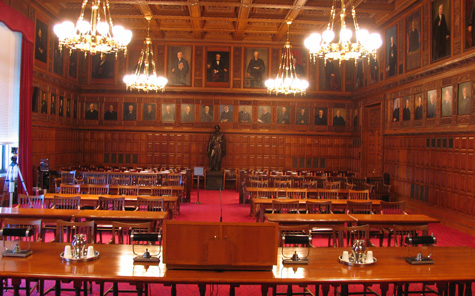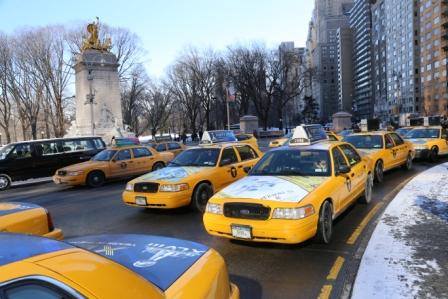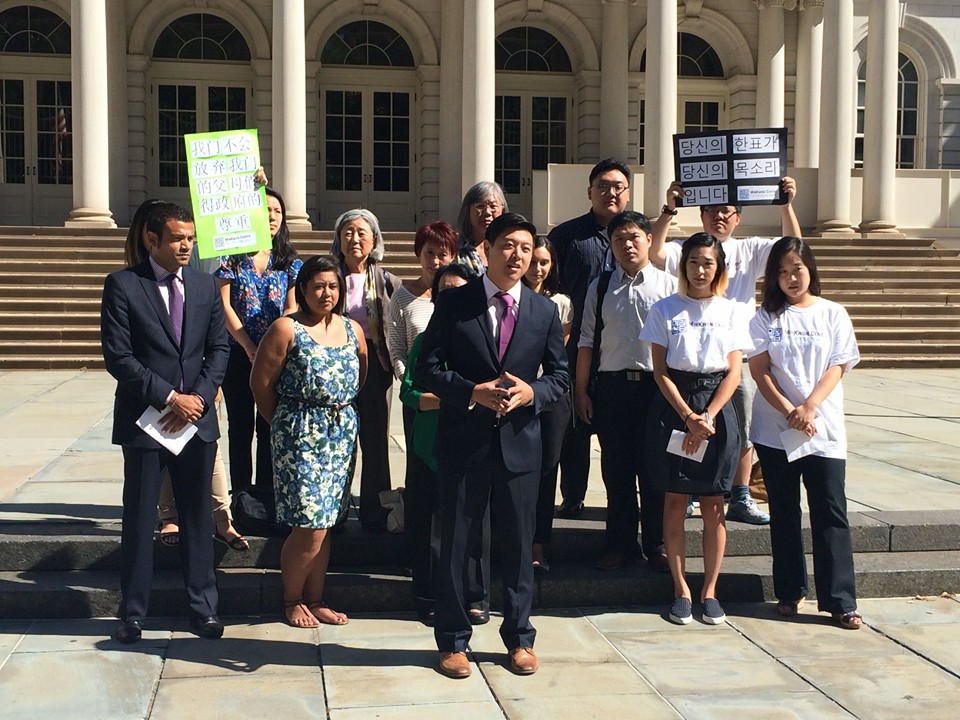Shut Down the Criminal Court

City Council Speaker Melissa Mark-Viverito should be commended for using her State of the City address, titled "More Justice," to call for criminal justice reform. She rightly observes that "we need more justice in the justice system" and ticked off some specific goals, including reducing the population at Rikers Island, creating civil procedures for minor violations, and improving the warrant process. However, the speaker must aim higher if she truly wants "more justice." More specifically, just as she referred to the "dream" of shutting down Rikers Island, so too should she call for abolishing the present Criminal Court.
While the tactics of the NYPD have been subject to vigorous debate, and the horrific conditions at Rikers Island have been increasingly exposed, the Criminal Court, the entity that reviews arrests and metes out sentences, has been free from any serious scrutiny.
Last year, about 350,000 people were arraigned in the city's Criminal Courts. More than 90% of the defendants were black or Latino. Only 14% of the cases were felonies and owing to Police Commissioner Bill Bratton's devotion to "broken windows" policing, misdemeanors and violations accounted for a whopping 81%. Almost 60% of those cases ended at arraignment, the accused's first appearance before a judge - a moment in time when the prosecutor, defense attorney, and judge don't know much of anything about the charges, the accused, the arresting officer, or any actual victim. This is not anyone's conception of a "court."
The speaker's call for "more" justice assumes there is already some amount present. It is hard to imagine the word "justice" occurring to anyone observing the court in action. Instead, it is as it has always been – an assembly line concerned primarily, if not exclusively, with rushing through cases. It is no secret that court administrators regularly evaluate judges on the speed with which they move their calendars and the number of guilty pleas they obtain in the process.
Most people assume that the Criminal Court adjudicates guilt or innocence with witnesses testifying under oath, an attentive jury, and a judge at the helm. In fact, there are virtually no jury trials in the Criminal Court as defendants are pressured in myriad ways to plead guilty or resolve their cases in any way other than a trial.
Consider this – the average time citywide from arraignment until the start of jury trial is 570 days. In the Bronx it is 826 days. Who can languish in jail or repeatedly come back to court for that long a period of time without experiencing emotional strain, missed work, missed school, etc.?
More deliberately pernicious is the time-honored "trial tax" – defendants are aware that they will get severely sentenced if convicted for having the temerity to exercise their constitutional right to a trial by jury. The result? In 2014, there were only 175 jury trials in the entire New York City Criminal Court (about 1/20 of 1% of the cases that entered the court the same year). On the other hand, there were about 175,000 guilty pleas.
Most people assume that the Criminal Court adjudicates the constitutionality of the arrest, as even non-lawyers are familiar with the prohibition against illegal search and seizure. However, pretrial suppression hearings, where officers testify under oath and judges determine whether they acted legally, are as rare as jury trials. It took a trial in federal court for a judge to find that the NYPD was engaging in hundreds of thousands of violations of the Fourth Amendment and the Equal Protection Clause. If the Criminal Court focused on its role as protector of constitutional rights and less on its self-imposed mandate to speed through cases, the stop-and-frisk debacle might have been stopped in its tracks years earlier.
What, then, does the Criminal Court actually do? Twenty-five years ago, a colleague examined Criminal Court data and argued that the court didn't do anything of substance. He found that the court failed to assure that persons accused of crime are accorded their rights under law, failed to seriously assess guilt or innocence, failed to mete out any kind of meaningful sentence to those ultimately convicted, and cost the taxpayer a huge sum of money. He pointed to the lack of adversarial litigation and concluded that the Court's essential function was taking guilty pleas to minor charges. As a result, he suggested it should be abolished.
I disagreed then, and still do now, with his finding that the Criminal Court didn't do much of anything significant. The Criminal Court does many things. Daily, it processes a multitude of young men of color, saddles them with arrest or criminal records, and renders them less employable, less likely to get into college, less able to get loans, less able to get licenses, etc. That reality breeds frustration, pain, anger, and alienation.
The Criminal Court brings in revenue. Ferguson, Missouri is not the only city that grows its coffers through its criminal justice system. In 2014, fines, surcharges, bail and related fees netted $31,884,569 - that's just under $32 million.
Ultimately, the Criminal Court is a highly efficient instrument of social control that maintains the status quo (or, as our Mayor might say, it perpetuates a tale of two cities).
Yet, while I reject my colleague's conclusion, I agree wholeheartedly with his ultimate recommendation -- the Criminal Court should be abolished. This goal is not so far-fetched. Consider that while advocates for prison abolition were initially seen as wild-eyed dreamers, we now hear that Speaker Mark-Viverito's "dream" of shutting down Rikers Island even has the support of New York Governor Andrew Cuomo.
Mayor Bill de Blasio conceded that the Criminal Court needed to be re-examined several months ago when he announced his "Justice Reboot" initiative. However, meaningful change requires more than shutting down and restarting or tinkering with the same basic program. The usual slate of reforms offered to improve the Criminal Court – generally centered around the supposed need for swifter dispositions – will accomplish little. A reduced backlog won't change the color of the defendants nor the continued meting out of unnecessary and undeserved criminal records.
Speaker Mark-Viverito recognizes the dysfunction that characterizes the Criminal Court. She is creating a commission, headed by New York's former Chief Judge Jonathan Lippman, charged with re-imagining "our entire criminal justice system."
To his credit, Judge Lippman has already promised to "pull no punches." That is exactly the right approach. The Criminal Court hasn't been fundamentally changed since its inception in 1962 and has repeatedly been referred to as a system in crisis. It is well past time for a new approach that focuses on assessing the nature and quality of justice delivered instead of the quantity and alacrity of cases disposed. Isn't that the true measure of a "court?"
***
Steven Zeidman is a professor of law at CUNY School of Law.
***
Have an op-ed idea or submission for Gotham Gazette? Email This email address is being protected from spambots. You need JavaScript enabled to view it.
No Surprise Uber Drivers Are Protesting

photo via the NYC TLC
Uber’s New York City drivers continued to rally against the company last week at City Hall — and it was no coincidence that recent reports show most Uber drivers don’t like their jobs.
In a new survey of Uber drivers published this month, less than half said they enjoy driving for Uber. Almost 40 percent of the drivers said they “strongly disagreed” or “disagreed” with the survey’s question about whether they were satisfied with Uber.
That survey included drivers from big cities across the country, but we know the major reason why New York Uber drivers are angry — 15 percent fare cuts that have made it impossible for them to make ends meet. Angry drivers here in the city have also called on Uber to stop taking a huge 20 to 25 percent cut of all their fares and add a tipping option to the app.
One might assume that a company that cares about its working-class drivers would take all these concerns seriously and address them immediately.
But Uber has shown its true colors by responding with a PR campaign aimed at convincing drivers that fare cuts are great and they should be happy with what they get.
That kind of callousness should offend all New Yorkers. We have all seen what it’s like to work for a rich company that cares more about the bottom line than the welfare of its workers. Uber’s disregard for its workers should also serve as an important reminder of why numerous driver protections — including strong wage protections — already exist in New York City’s taxi industry.
The fact is that industry regulations — developed over many years by government officials and medallion owners — ensure that taxi drivers never have to face the problems that are forcing Uber’s New York City drivers to protest and even go on strike.
No one can reduce a taxi driver’s fare because that is illegal. The government cannot take up to 25 percent of a taxi driver’s fares because that is illegal.
Additionally, the taxi industry encourages riders to tip generously by offering suggested tip amounts through the payment system mandated within each cab.
Taxi regulations are simple and straightforward. No one can blame Uber drivers for wanting the same protections in the workplace. But who should be blamed for the fact that those protections don’t exist?
The blame should really be shared between Uber and the city’s Taxi and Limousine Commission - the latter has failed to address this and many other double standards that exist between Uber and the taxi industry.
Since Uber has shown it is unwilling to respect its working-class drivers, even as they continue to protest, the TLC has a moral and legislative duty to act by imposing real regulations that create parity between Uber and the taxi industry.
The TLC was created not only to protect the general public but all of its stakeholders, and over the past several years the TLC has vastly increased driver protections throughout the industry — except when Uber is involved. Uber continues to receive a pass from the TLC in avoiding all of its regulations, including fares, accessibility, driver protections, vehicle choice, branding of cars for public protection, paying a state tax to support the MTA, surge pricing, and more.
Until the TLC creates an even playing field for drivers, the public, and the rest of the for-hire industry, Uber drivers will continue to be dissatisfied and struggle to earn the money they need to support themselves. That’s no longer a claim — it’s a fact.
And as long as Uber ignores drivers and the TLC fails to solve the problem, there is always another option for angry Uber drivers. We would be happy to have them join the taxi industry and gain the same wage protections that yellow cab drivers have enjoyed for so many years.
It looks like the door to Uber’s front office is closed to workers. Ours is open.
***
David Beier is the President of the Committee for Taxi Safety. On Twitter @CommTaxiSafety.
***
Have an op-ed idea or submission for Gotham Gazette? Email This email address is being protected from spambots. You need JavaScript enabled to view it.
Special Election Shows Need for Democratization

Charles Youn, executive director of KALCA, speaks at a press conference
Any good democracy should reflect a society’s diversity in its leadership. The undemocratic way in which the 65th Assembly District special election is unfolding should galvanize all communities, particularly underrepresented ones, to push for reforms and encourage underrepresented New Yorkers to be more civically engaged.
America does not always have accurate and inclusive representation in government. This is especially true in state legislatures. A few weeks ago, a study released by the New American Leaders Project found several distressing trends. Although 38% of the U.S. population identifies themselves as people of color, only 6% of state legislators come from such a background. Furthermore, the New American Leaders Project’s survey of non-white legislators found that during some of their campaigns, they were actively discouraged from running by their own political party.
This problem is painfully apparent in New York. For the past 40 years, Sheldon Silver ruled over the 65th Assembly District, commonly referred to as a majority-minority district. This district includes Chinatown, a neighborhood that has steadfastly served as the epicenter of growth and opportunity for many Asian immigrants since the 1900s.
Silver is said to have had a vice-like grip on his seat, and only released his hold when the courts forced him to leave upon a federal corruption conviction. His departure and the subsequent special election should have given New Yorkers the opportunity to vote for new candidates who actually reflect their community. However, residents of the district were robbed of that opportunity.
Since the announcement of the special election, the deck was stacked against any possible candidate outside the local political machine, one which Silver still controls. On January 30, despite the protests of the media and good government groups such as Common Cause New York, a special election date of April 19 was announced, which was five months earlier than the strongly suggested September 13 New York State primary date. Just a few hours later, local blogs and newspapers revealed that the Democratic County Committee, a subset of the state Democratic Party, would determine the Democratic nominee for the special election in one week, effectively ending an election just seven days after its start.
The candidate the local county committee selected on February 6 was Alice Cancel, the wife of the Democratic County Committeeman and political club boss of the Lower East Democrats, John Quinn. Cancel has had no qualms praising Silver.
The quick and fixed process prompted one candidate, Yuh-Line Niou, to refuse to be considered for the Democratic line, stating that “this process is not one anyone would have chosen to reflect the diversity of our district, and to be fully democratic.”
The election in April will be a farce, with only one name on the Democratic ballot line in a district where Democrats outnumber Republicans 8 to 1. Come fall, the Democratic pick will have an incumbent advantage, and Chinatown may once again be represented by someone who has not democratically earned the right to do so.
This is a mockery of American democratic values, and we must all act to ensure it does not happen again.
There are two ways we as concerned citizens can do so. First, push to adopt the policy recommendations from Citizens Union’s 2013 report on political clubs to curb excess influence over institutions like the Democratic County Committee. The report found that the financial and personal ties within and among political clubs, machines, and individual politicians were suspect and strong. For example, during the 2011 federal trial of former City Council member Larry Seabrook, it was discovered that he had used the Northeast Bronx Democratic Club as his personal ATM. To fix this, Citizens Union recommended that a political club’s financial activities be transparent and regulated.
Citizens Union recommends, among other things, defining precisely what constitutes illegal coordination between political clubs and candidates’ campaigns.
Secondly, underrepresented communities must become more civically engaged. During the midterm elections in 2014, Asian-American voter turnout was abysmal—only 4% of the eligible population voted. We can and must do better.
Civic engagement does not start or stop at the polls. Being engaged means joining a community board, voting in primaries, participating in candidate forums, reading political news, and joining organizations that advocate for people’s rights.
What has happened in Chinatown proves that now is the time for our underrepresented communities to get involved and make a difference.
***
Serin Choi is the Advocacy Chair for the Korean American League for Civic Action, a non-partisan non-profit organization that advocates for increased Asian leadership in the public sector.
***
Have an op-ed idea or submission for Gotham Gazette? Email This email address is being protected from spambots. You need JavaScript enabled to view it.




